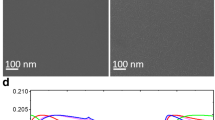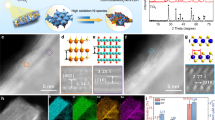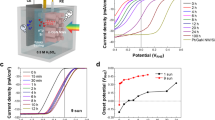Abstract
FOLLOWING Fujishima and Honda's suggestion of water photolysis by a photoelectrochemical cell1, no stable cell has been reported (but compare refs 2, 3) capable of water decomposition without the application of either an external bias or a pH gradient. The main problems have been to find stable anodes and cathodes with sufficiently negative and positive critical photopotentials, respectively, so that they may be suitably combined in a self-driving photo cell producing hydrogen and oxygen from water. We report here that the anodes n-TiO2 and n-SrTiO3 and the cathodes p-CdTe and p-GaP can be combined to form four separate stable self-driven cells: n-TiO2–p-CdTe, n-TiO2–p-GaP, n-SrTiO3–p-CdTe and n-SrTiO3–p-GaP capable of water photoelectrolysis.
This is a preview of subscription content, access via your institution
Access options
Subscribe to this journal
Receive 51 print issues and online access
$199.00 per year
only $3.90 per issue
Buy this article
- Purchase on SpringerLink
- Instant access to full article PDF
Prices may be subject to local taxes which are calculated during checkout
Similar content being viewed by others
References
Fujishima, A. & Honda, K. Nature 238, 37–38 (1972).
Mavroides, J. G., Tchernev, D. I., Kafalas, J. A. & Kolesar, D. F. Mater. Res. Bull. 10, 1023–1030 (1975).
Watanabe, T., Fujishima, A. & Honda, K. Bull. chem. Soc. Jap. 49, 355–358(1976).
Author information
Authors and Affiliations
Rights and permissions
About this article
Cite this article
OHASHI, K., MCCANN, J. & BOCKRIS, J. Stable photoelectrochemical cells for the splitting of water. Nature 266, 610–611 (1977). https://doi.org/10.1038/266610a0
Received:
Accepted:
Issue date:
DOI: https://doi.org/10.1038/266610a0
This article is cited by
-
Photoelectrochemical technology for solar fuel generation, from single photoelectrodes to unassisted cells: a review
Environmental Chemistry Letters (2022)
-
A titanic breakthrough
Nature Catalysis (2021)
-
Electronic Structures of Free-Standing Nanowires made from Indirect Bandgap Semiconductor Gallium Phosphide
Scientific Reports (2016)
-
Semiconductor nanowires for photovoltaic and photoelectrochemical energy conversion
Frontiers of Physics (2014)



